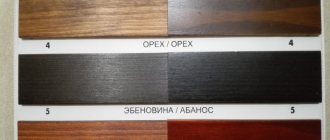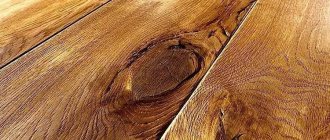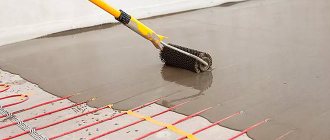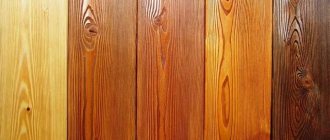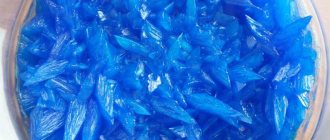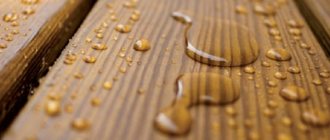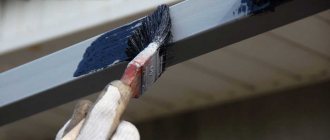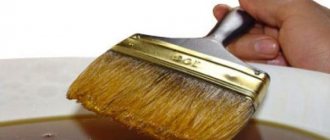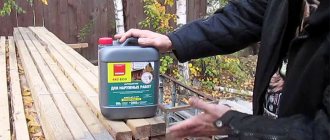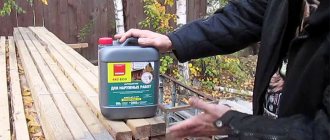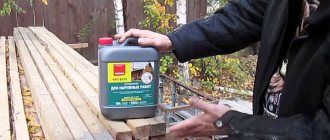Impregnation of wood with various oils protects the material from diseases and pests, thereby increasing the service life of a wooden structure or product.
Used machine oil is also suitable for processing wood, impregnating boards to protect the wood from rotting, for example, before painting a fence, as evidenced by reviews from people who have already tried this method.
However, due to its chemical composition, this oil is less versatile, and to achieve the greatest effect it must be used correctly and take into account the negative impact on the wood.
What does wood processing do?
Wood is a porous material, so any liquid that gets on the surface of a board or beam is absorbed into it and penetrates to a certain depth, which depends on the type and moisture content of the wood .
Penetrating into the wood, petroleum products and other waste components displace moisture from the cells and also reliably preserve them, preventing further entry of air and water.
If at this moment there are diseases or pests in the wood product, then they die from a lack of moisture and oxygen, with the exception of some types of mold, which require treatment with “Whiteness” or other similar preparations to defeat them.
The greatest effect from impregnation of wood products is obtained when they are used in places of high humidity, for example, buried in the ground or placed next to areas of condensation .
After all, mining creates a protective layer several mm deep on the surface of a board or other part (depending on the viscosity of the material and the number of layers, as well as other conditions, which we will discuss below).
Therefore, even deep scratches and dents do not provide access to water and oxygen to the inner wood, which means the rate of its decomposition is reduced tens or even hundreds of times.
However, this material destroys the structure of wood, so it is undesirable to impregnate supporting structures with mining, so as not to cause their weakening. The exception is load-bearing structures made of timber or oversized logs; in this case, mining, although it softens the outer layer of wood, protects the inner layers .
Use of waste machine oils
The use of machining as a coating for timber is widely welcomed in rural areas. Used engine fluid covers hangars, garages, sheds, warehouses, attics and fences. When coated with waste oil, boards and wooden sections that have already been exposed to negative destructive factors are also protected from subsequent destruction and rotting of the wood.
When covering a building or fence, you should take into account the change in color of the structure; the wood loses its natural color, which cannot be corrected further. To avoid an unpleasant tint of wood, it is recommended to apply an oil solution to the lower part of the fence or structure, and paint the upper part with a substance that preserves the aesthetic appearance of the wood.
Small parts, ends, wall partitions, and the insides of walls are also treated with machine mortar, which contributes to their longevity and high-quality processing in an inexpensive way. One of the main structures that is most often covered with machine waste is the fence. Contacting directly with the ground, a wooden fence is subject to moisture and rotting; with the help of oil treatment, the fence acquires additional protection from moisture and destruction.
For such structures, it is recommended to use oils for passenger cars - these types of oils easily erode, getting rid of the unpleasant pungent odor and negative destructive properties.
In addition to structures made of wood and boards, oil impregnation can also be used for metal parts and concrete products, which prevents the appearance of rust and mold, protecting structures from destruction.
How to process boards, logs or timber?
To properly process wood products, adhere to the following order:
- prepare the product for processing;
- prepare the treatment for application to wood;
- apply the liquid in compliance with safety precautions;
- dry the product.
Preparation of wooden products
Only finished products tailored to the specific installation location are suitable for treatment with waste oil.
For example, floor joists must be cut to size , but if you plan to make any cuts or holes in them, then this must be done before processing.
After all, after impregnation, the wood will be covered with a protective oil layer, so any change in shape or mechanical impact can destroy this protection and negate the entire effect of painting with such a material.
If you are building something from wood with natural moisture, then it is not advisable to dry the part separately before impregnation, because then the moisture deformation, as well as the drying of this part and the rest of the structure, will proceed differently , which will lead to the appearance of cracks.
If you are building a structure from a material with a moisture content of 12–18%, then it is enough to dry the product intended for impregnation along with the rest of the material.
Preparation of testing
At temperatures of 0–30 degrees, the viscosity of waste oil is very high, making it difficult for it to penetrate into the pores of wood, so it must be prepared before application.
There are 3 methods of preparation , which can be used either separately or in combination with each other:
- adding solvent;
- burnt;
- mixing with bitumen.
Adding solvent
This method of preparation increases the ability of the material to penetrate the pores, but reduces the effectiveness of wood conservation and the antiseptic effect.
The best solvents are:
- White Spirit;
- kerosene;
- diesel fuel.
Their advantage is that they are less fire hazardous than gasoline, but at the same time provide the same level of penetration into the deep layers of the wood product. The optimal ratio is 5:1 , that is, to dilute five mass parts of used oil, one mass part of solvent will be required.
Pour the solvent into the waste container and mix until a homogeneous mass is obtained, then immediately apply the resulting composition to the wood.
Heating
This preparation method increases the ability of impregnation to penetrate into the depths of a wooden product, and also improves antiseptic properties, because exposure to temperatures of 70–120 degrees is detrimental to most microorganisms and pests. Heat the liquid over an open fire , focusing on its viscosity. As soon as the consistency becomes similar to diesel fuel, start painting the wood.
Remember, the temperature of heated waste exceeds 100 degrees, so even one drop falling on the skin will cause severe burns that will take several months to heal.
Therefore, be sure to wear clothes made of thick fabric (a canvas robe is best) and thick canvas or felt gloves, and also avoid getting hot oil even on your clothes. If you get a burn, then consult a doctor immediately, because self-medication will only do harm in an already difficult situation.
Adding bitumen
If you add bitumen to the mining, the service life of such a coating will increase several times.
Typically, the mining coating must be renewed by applying a new liquid every 3–5 years , but if bitumen is added, the minimum period after which re-treatment will be required will be 20–30 years.
The oil-bitumen mixture can be either heated or diluted using a solvent.
The first method creates a more durable outer layer of coating without reducing the antiseptic effect, therefore it is better suited for treating load-bearing fence posts, because they are constantly in contact with the ground.
The disadvantage of this method is the increased fire hazard, as well as the high likelihood of severe burns.
The second method is less dangerous, because it does not involve the use of open flame, and the mixture, even if it gets on the skin, will not cause a burn and can be removed with dishwashing detergent.
In addition, impregnation penetrates much deeper than the heated mixture, due to which the wood preservation effect is much stronger . Therefore, this processing method is better suited where it is necessary not only to protect the wood from external moisture, but also to slow down the natural destructive processes in the wood as much as possible.
Application of impregnation
To effectively apply this impregnation, use these tools :
- solution container;
- wide paint brush with natural bristles, 50–70 mm long;
- paint roller with oil-resistant coating;
- rag kvach, that is, a stick with a rag wrapped around it.
Here are the most convenient application methods:
- Pour a little solution onto the surface of the wood, then spread it onto the wooden piece; this is convenient to do if the wooden piece is lying on the table, and the best tool is a brush.
- Dip your brush, roller or kvach in the prepared composition, then carefully coat the surface of the wood, avoiding any gaps. This method works well for parts that are already in place.
- Dip the end of the wooden part into a container with a solution; this method is suitable for treating the lower ends of the posts, on which the fence veins will then be installed.
Remember, hot bitumen-based composition is slowly absorbed, so while it is still hot, it must be rubbed into the workpiece. If you dip the lower parts of the pillars in such a solution, then immerse the parts in the liquid several times for 5–10 seconds .
If you want to saturate entire parts with this solution, then apply it with a brush or kvach, carefully rubbing into the surface.
Since bitumen-based mixtures penetrate shallowly, applying more than one layer is pointless.
To increase protection, first treat the part with a solvent-based mixture, and after a day apply a bitumen composition.
Apply the solvent-based mixture with a brush or roller in several layers, the absorption time of each layer is 5-10 minutes. You can wait less, but then the soaking will be less effective.
Each layer will dry completely in about a week, but you can install a wooden product impregnated with waste in just a day; the oil will no longer stick to your fingers, although feathers and leaves will still stick to it.
After a week, when the impregnation has completely dried, the painted surface will not differ in tactile sensations from unpainted wood.
If you plan to fasten the products with nails or self-tapping screws, then after installation and fixation, paint the fasteners with the same composition.
Do not use spray guns (spray guns) to apply mixtures, because the waste contains a lot of waste and various dirt, so the device will constantly become clogged, and all rubber seals will begin to collapse under the influence of petroleum products.
You can try to clean the material using a homemade stand consisting of an oil pump with a motor and a car oil filter, but even in this case only an ejector sprayer with a powerful air compressor will do.
Painting with machine oil
To work with wood, you need to prepare all the necessary tools and parts:
- Prepare the oil, or pour all the remaining oils into one container and mix thoroughly to obtain a composition that is uniform in color and consistency.
- Oil painting should be applied only with rubber gloves, avoiding contact of the oil solution with the skin.
- Before applying the product, the wood must be cleaned with sandpaper and wiped with a cotton cloth just before coating, removing dust from the product.
- Prepare a product for applying oil painting.
Applying protective liquid to wood can be done in several ways, using various equipment:
Using brushes of various sizes, you can paint small parts of wooden structures, including ends, bevels and other small structures. The roller will reduce the coating time for larger products and boards, while reducing the amount of material consumed. When working with a roller, it is recommended to prepare an additional brush for touching up bends, cracks, corners and other details.
If you have a sprayer, you can quickly and efficiently paint fences and entire wooden structures. Impregnation in this method can be carried out without a brush, however, the used sprayer is not recommended for use for other types of work.
Thus, used machine oil is an excellent means for impregnating, painting and protecting fences, wooden buildings, metal and concrete parts. This product is easy to use, inexpensive, and has a fairly effective effect on wood.
Every motorist has a container with reserves of used motor oil in his garage. When the quantity of a given product increases in volume, a natural question arises: where to put it? Use of used oil can be varied and it is not necessary to recycle it. In addition to waste machine oil, residual vegetable oil is also used in households.
Painting the fence
It is better to process all the details of the future fence before its installation; this is especially true for poles, because without protection their service life is unlikely to exceed 5–10 years , depending on soil moisture.
Impregnate the pillars with solvent-based mixtures, and after drying, paint them with a bitumen compound. After about a week, the pillars will be suitable for digging into the ground.
Impregnate the remaining parts, that is, the veins and the picket fence, with solvent-based mixtures; do not use bitumen preparations, because they not only look worse after drying, but also soften under the influence of sunlight.
Apply cold impregnation in 3-5 layers, it will take 30-60 minutes, then wait a week until it dries completely and only then mount the fence.
Don’t forget to paint the nails or screws that you used to connect all the parts together; if you don’t do this, moisture will get inside the wood through the destroyed or protective cover, which will dramatically accelerate the destructive processes in it. Every 3 years, impregnate the fence with such solutions, this will extend the life of the product.
A folk remedy invented by scientists
If you really want to make impregnation yourself, you should turn to proven methods. In Soviet times, in the Senezh Wood Conservation Laboratory of the TsNIIMOD Ministry of the Forestry and Woodworking Industry of the USSR (yes, it’s a long read), a safe composite “BB-11” was developed - it is harmless to humans, protects against biological damage and does not change the color of wood, since it was originally developed for restoration valuable wooden objects in Karelia. It is prepared as follows:
- 173 g of technical borax;
- 173 g boric acid;
- 3,094 liters of water.
This is a composition for processing 1 square. m. From a mixture of borax salts and acid, you need to prepare a 10% aqueous solution, and before applying, heat it to 40 0 C. Apply the mixture with a soft brush to the wood - either seven times, or after a single application, cover the treated surface with polyethylene, securing it with push pins. Of course, if this is a facade, you won’t have enough polyethylene; you will have to process it in seven layers (you don’t need to wait for the previous layer to dry). This product meets all the requirements and at the same time can be considered a “folk” recipe.
How to paint the framed (lower) crown or the entire frame?
If you decide to paint the trim crown in order to increase its resistance to condensation and extend its service life before repair, as well as when laying a new crown to replace the old one, then keep in mind that working off softens the wood, even if only on the outside .
Therefore, the less it penetrates deeper, the stronger the crown will be. Bitumen-based solutions are best suited for this treatment.
After all, they penetrate shallowly, due to which the softening will be minimal, and after hardening the mixture turns into a crust that reliably protects the wood from street moisture.
If you plan to saturate the entire log house with mining, then keep in mind that it is extremely undesirable to impregnate the inner surface of the walls with this material, with the exception of various utility rooms where people will not stay for a long time .
For this type of work, use solvent-based compounds and apply them with a brush or roller.
Do not use ejector sprayers to apply the mixture, as they spray the mixture heavily, which reduces the depth of its penetration. Apply 3-5 layers, giving each layer time to dry (at least 5 minutes).
Apply the compound only to well-dried walls, that is, in late summer - early autumn. Before painting, be sure to eliminate all defects in the walls, repair damage and sand the walls.
Do not saturate the walls if less than a month has passed since the last rain, otherwise the moisture that the wood has absorbed will remain inside the log or beam, which will sharply accelerate all destructive processes , which will reduce the service life of the log house.
Product Application Options
Used car engine oil and used vegetable oil should not be poured onto the ground. For this, there are special recycling companies that even pay for used oil materials. If the volume of waste liquid is small, then there is no need to contact such a company, and there is no point in collecting such a product. Therefore, it is worth considering reusing the substance.
You can do a lot with used oil in your household. Oils have a primary function - waterproofing, which protects any surface. Used oil can be used for more than just moisture protection. Processing is applicable to protect the material from aggressive atmospheric influences. Regarding vegetable oils, the range of applications is not as wide as that of motor oil.
- You can process the tree from above. This will add shine to the surface, change color, change texture and preserve the fibers from rotting.
- The substance has found active use in relation to iron structures. Metal treated with this product is not susceptible to rust and corrosion.
- Lubricating rusty mechanisms (bicycle chain, door hinges). During processing, it is important to thoroughly lubricate all components of the mechanism.
- They often resort to using motor waste if a combustible mixture is needed. The components that make up the substance burn for a long time. Thanks to this “helper” you can burn even wet raw materials.
Thus, the waste is used on the farm as a primer for boards. When processing wood and metal, this product is simply irreplaceable. Lighting up a grill or boiler will not be a problem. Plus, it saves money.
Processing house cladding
If you want to impregnate the wooden cladding of a house made of brick or any other material, then do this work only in late summer or early autumn, when the moisture content of the boards is minimal.
If the house was previously painted, use a metal brush to remove all traces of paint from the surface of the wood, then sand the boards with sandpaper to remove lint . Repair all minor defects, but if some boards are severely damaged, replace them, then apply the polish with a brush or roller.
If the shape of the boards is different from rectangular, for example, there are chamfers on the sides of the outer surface, then use only a brush, because the roller will not be able to saturate the recesses with oil.
Apply 3-5 layers of polish with an interval of at least 5 minutes, but do not overdry; if several hours pass, the penetration depth of the next layers will be noticeably less. If the wind rises, then inspect the surface of the sheathing for 2-4 days and remove the adhering foliage from it , but if you do not do this, then after the working has completely dried, it will be much more difficult to do this.
Pros and cons of mining impregnation
Before you apply treatment to wood boards and beams by impregnation with waste oil, study all the pros and cons of this method.
The only advantage of impregnation with such material is the minimal cost of processing, which makes it possible to protect wooden structures at minimal cost.
There are many more disadvantages to painting with waste oil.:
- penetration depth is less than that of water-based antiseptics;
- after drying, the treatment not only protects from external moisture, but also prevents moisture from escaping from the wood, so processing the boards is most effective only on thoroughly dried wood, and this is not always applicable;
- even after drying, the waste continues to release harmful substances;
- due to the high soot content, the mining strongly blackens the wood, making it darker;
- despite the fact that impregnation does not reduce the ignition temperature of wood, the smoke emitted by the painted material is many times more toxic than that of pure or impregnated wood;
- preparing and applying any solutions based on waste can only be done in the fresh air, and the use of mixtures that include bitumen is not only a fire hazard, but can also lead to severe, long-healing burns;
- waste oil softens wood, so it cannot be used to treat load-bearing structures.
Now you can decide for yourself whether it is possible to impregnate the boards and whether it is permissible to treat them in this way if the wood is damp.
How to impregnate timber from rotting
The process of impregnation of timber is fundamental in the construction of such buildings. Since it increases the reliability and wear resistance of the building material, which in turn affects its service life. Impregnated wooden beams are a solid foundation for any home.
Carrying out this work is not an easy task.
It requires caution and accuracy. This is especially true when choosing the mixture used and the type of wood being processed.
Some perform only a protective function, while others also paint. The use of these funds is different. The location of the treatment is also taken into account: inside or outside the building. You can treat the timber with copper sulfate, sunflower oil with propolis, Finnish composition, birch tar, antiseptic, waste oil.
